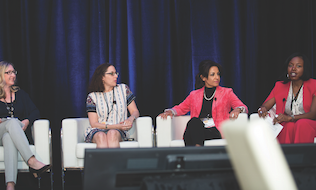
During the Healthy Outcomes conference in June, a panel of health and wellness leaders discussed some of the small steps their organizations are taking to achieve a healthier workforce.
Speaking on the panel, Lyne Moussa, manager of wellness, safety and disability at Coast Capital Savings Credit Union, emphasized that it’s essential to align health and wellness strategies to corporate ones. “My company’s purpose is to empower financial well-being, so I try to mould health and wellness language around that: the cost of poor health to people’s families, on their mental health and to the organization,” she said. “It’s an easy comparison to make.”
Read: 2017 Group Benefits Providers Report: Insurers playing a role amid rising emphasis on mental health
Moussa added that when creating health and wellness programs, it’s also important to consider the ability to introduce them across the organization. “We have small branches across the country where our frontline people work,” she said. “We can’t disengage these employees by only having events and programs at head office.” Shana Kapustin, Canadian director of human resources and global talent acquisition at Synnex Corp., faces similar challenges.
“To provide programs for all our locations, we partner with local resources and offer bonuses to encourage employees to adopt healthier behaviours,” she said.
Panel members agreed that partnerships are key when operating on a tight budget. Lisa Gilmour, manager of health, safety and wellness initiatives at Hamilton Health Sciences, said her organization is able to deliver a variety of health and wellness programs thanks to partnerships throughout the community.
“We look for opportunities to partner,” she said. “We have health and fitness students from Mohawk College do health screenings for us — blood pressure, weight, waist circumference — as well as personal training,” she said.
Read: What resources can employers use to assess employee well-being?
“In addition, we invite several massage schools to come and do free massage sessions for our employees.”
Moussa noted her team also reaches out to the community. “We regularly invite pharmacists, naturopaths, chiropractors and other people to come in to talk,” she said. “We have huge turnouts, and people feel they work for a company that cares about their well-being.”
Partnerships are just one part of a successful wellness program for Heather Ricketts, Sleep Country Canada Inc.’s national director of human resources. Participation from senior managers is also critical.
“Our CEO is our mental-health champion,” she said.
“Because of his reputation within the company for integrity, he has helped open up conversations. In fact, he receives very personal emails from employees expressing their gratitude for the role he plays. We’ve had a lot of success.”
Read more coverage from the 2017 Healthy Outcomes conference
